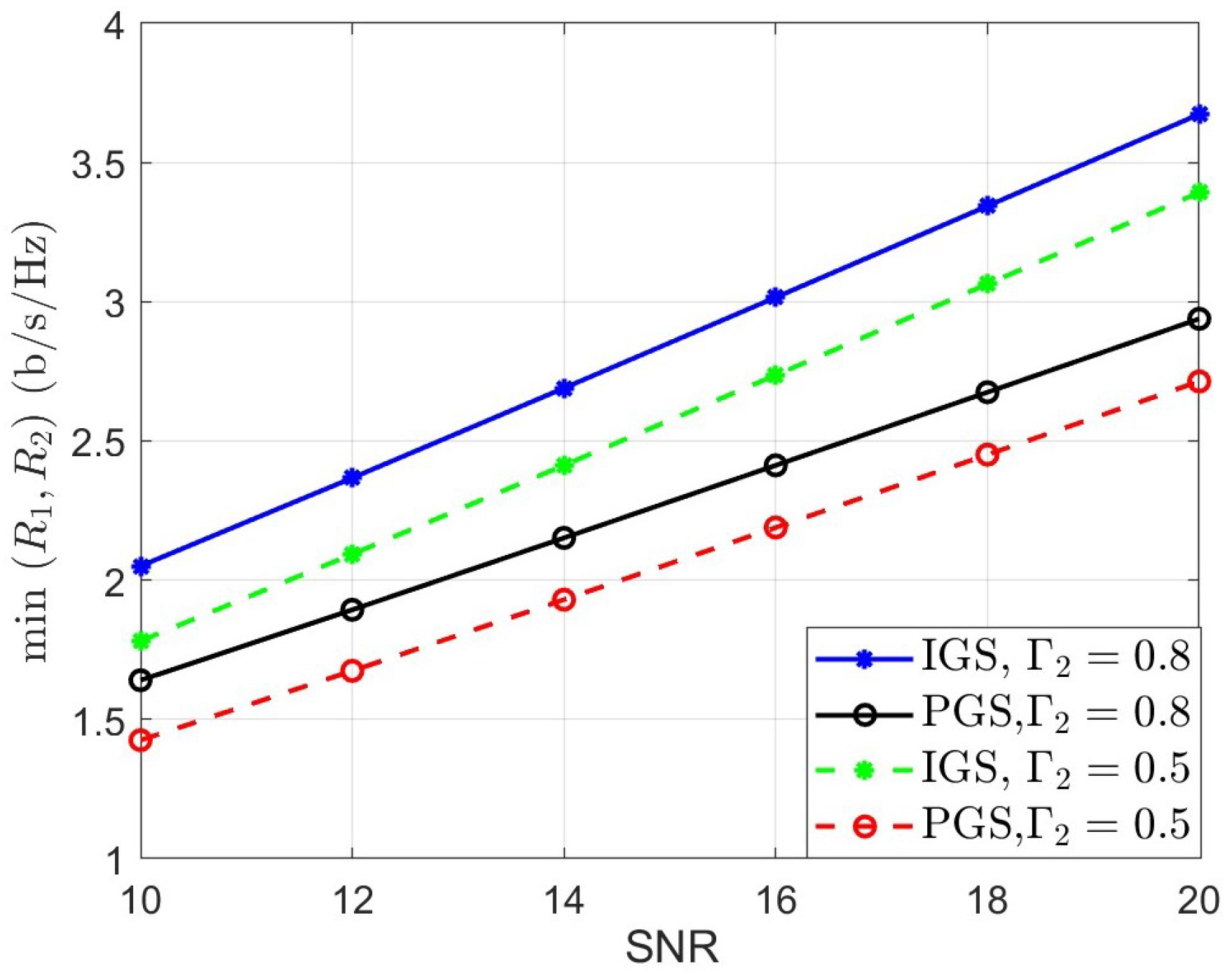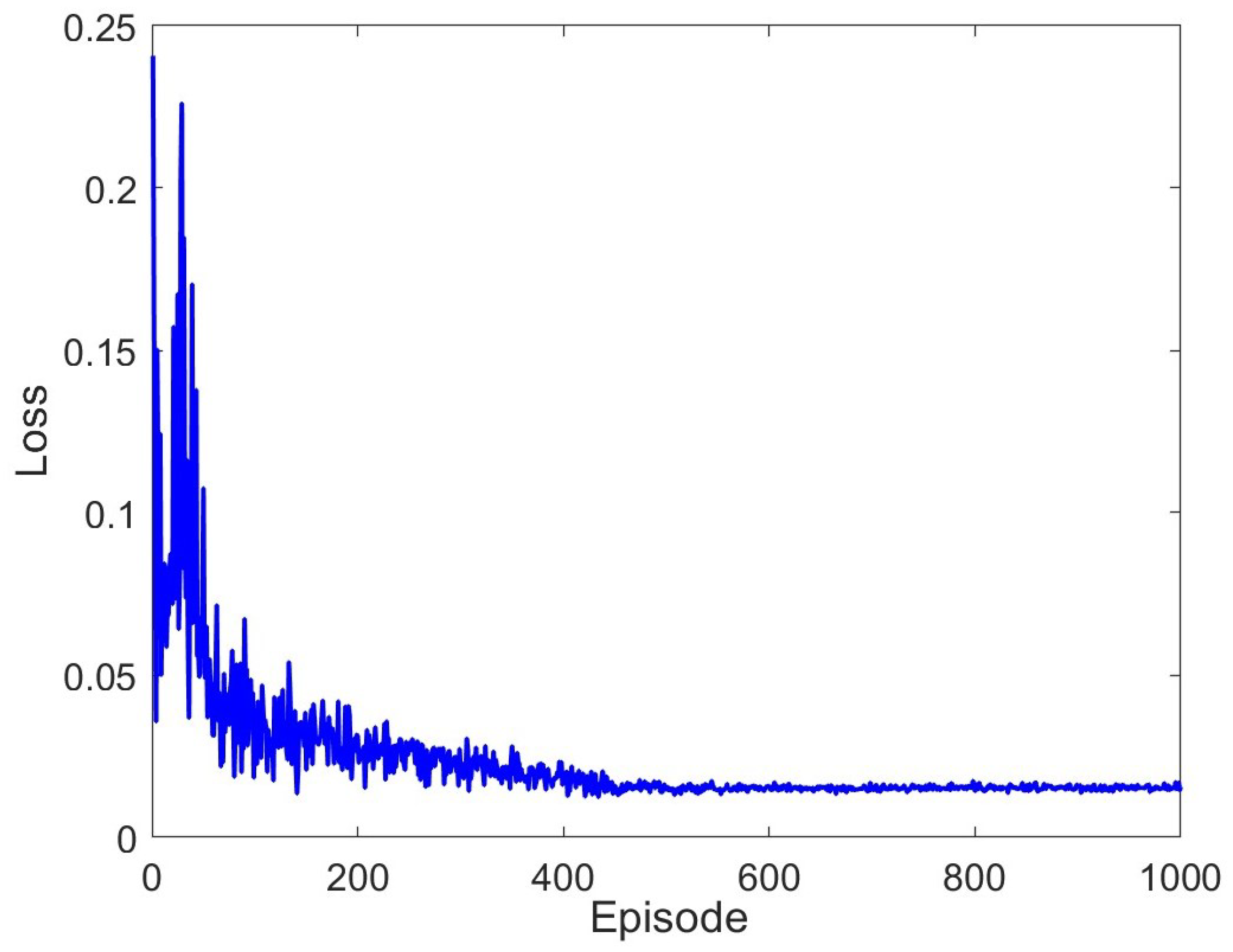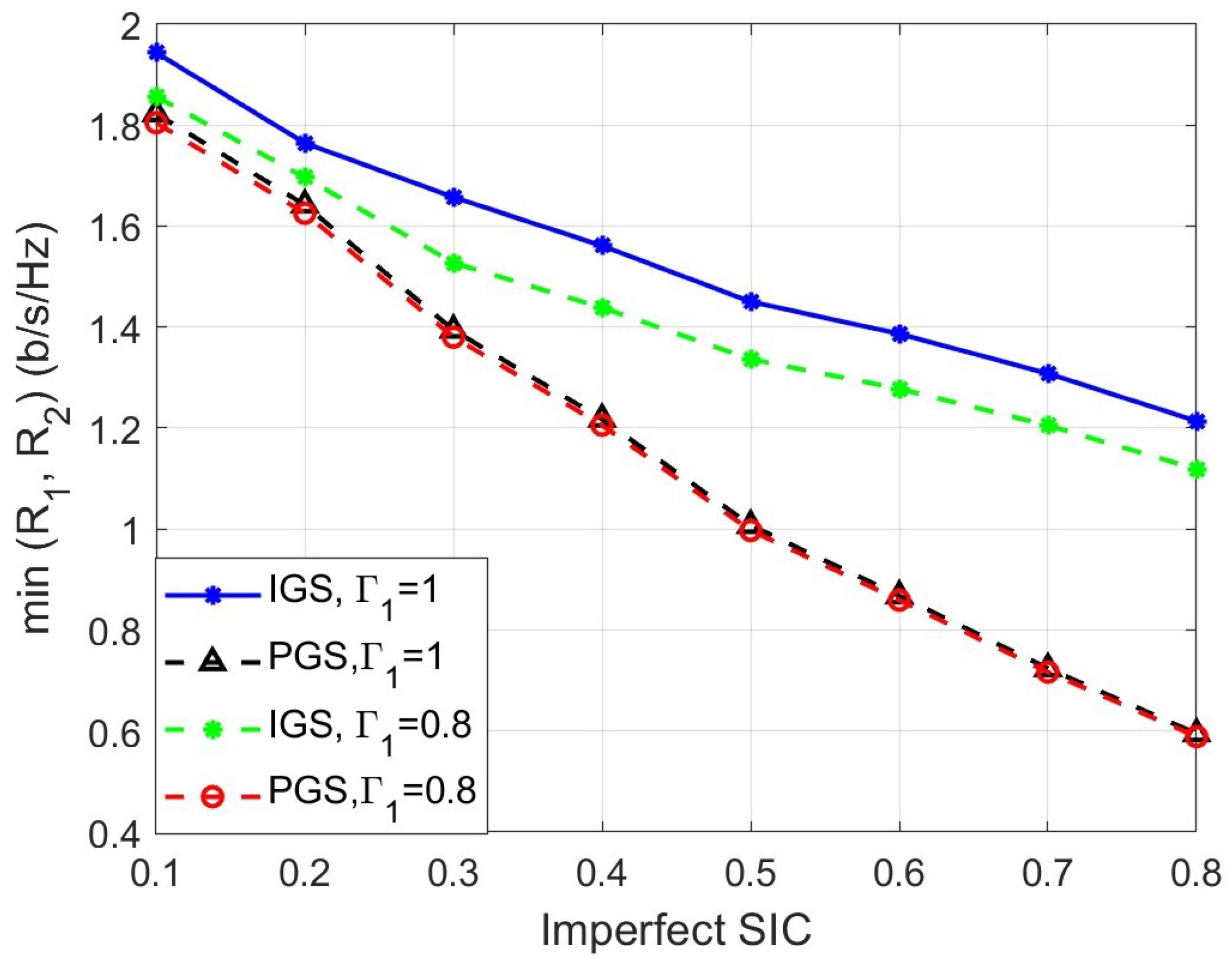On Rate Fairness Maximization for the Downlink NOMA with Improper Signaling and Imperfect SIC
Abstract
1. Introduction
- The max–min optimization of the NOMA system employing IGS is formulated under perfect SIC. To solve this problem, the alternate optimization (AO) technique is utilized to iteratively optimize the impropriety degrees and power level.
- The fairness optimization of the IGS-based NOMA system is formulated under imperfect SIC. To address this issue, a DQN-based suboptimal solution is proposed to learn the impropriety degrees and power levels of both users.
- The simulation results confirm the effectiveness of the IGS-aided NOMA system and highlight the improvements introduced by IGS as compared to PGS.
2. System Model
2.1. Preliminaries for Improper Gaussian Random Variables
2.2. System Description
3. Fairness Maximization of the NOMA System with IGS Under Perfect SIC
3.1. Optimal Design for IGS-Based NOMA with Perfect SIC
| Algorithm 1: Bisection-based algorithm for solving (23) |
|
3.2. Optimal Design for IGS-Based NOMA with Perfect SIC
3.3. Optimal Solution for PGS-Based NOMA with Perfect SIC
4. Fairness Maximization of the NOMA System with IGS Under Imperfect SIC
- 1.
- State space: The state space is defined aswhere is the reward obtained in the last timeslot.
- 2.
- Action space: The action space involves different levels of power and impropriety degrees. Let the power and impropriety degree levels uniformly distribute in and , respectively. The corresponding quantized intervals are assumed to be and , and thus the power and impropriety degree levels can be calculated as and , respectively. In this way, the action space is defined aswherein which The adaptive -greedy strategy is used to conduct action selection, provided by
- As time goes on, the action selection strategy becomes less inclined to take a random action from . In this sense, the decreasing probability at timeslot t, defined asis used in this work, where , , T, , and are the initial exploration probability, the minimum exploration probability, the number of training timeslots, the number of training episodes, and the time sample of the current training episode, respectively.
- Take the action that maximizes the Q-value with probability .
- 3.
- Reward function: The immediate achieved fairness data rate is defined as the instantaneous reward, provided by
| Algorithm 3: Rate fairness maximization for the downlink NOMA with IGS and imperfect SIC: the DQN solution |
|
5. Simulation Results
5.1. Fairness Rate for the IGS-Based NOMA Under Perfect SIC
5.2. Fairness Rate for the IGS-Based NOMA Under Imperfect SIC
6. Conclusions
Author Contributions
Funding
Institutional Review Board Statement
Informed Consent Statement
Data Availability Statement
Conflicts of Interest
References
- Wang, C.; You, X.; Gao, X.; Zhu, X.; Li, Z.; Zhang, C.; Wang, H.; Huang, Y.; Chen, Y.; Haas, H.; et al. On the Road to 6G: Visions, Requirements, Key Technologies, and Testbeds. IEEE Commun. Surv. Tutor. 2023, 25, 905–974. [Google Scholar] [CrossRef]
- Chafii, M.; Bariah, L.; Muhaidat, S.; Debbah, M. Twelve Scientific Challenges for 6G: Rethinking the Foundations of Communications Theory. IEEE Commun. Surv. Tutor. 2023, 25, 868–904. [Google Scholar] [CrossRef]
- Atzori, L.; Iera, A.; Morabito, G. The Internet of Things: A survey. Comput. Netw. 2010, 54, 2787–2805. [Google Scholar] [CrossRef]
- Zanella, A.; Bui, N.; Castellani, A.; Vangelista, L.; Zorzi, M. Internet of Things for smart cities. IEEE Internet Things J. 2014, 1, 22–32. [Google Scholar] [CrossRef]
- Zhong, Y.; Dutkiewicz, E.; Yang, Y.; Zhu, X.; Zhou, Z.; Jiang, T. Internet of mission-critical things: Human and animal classification-A device-free sensing approach. IEEE Internet Things J. 2018, 5, 3369–3377. [Google Scholar] [CrossRef]
- Zhao, H.; Tan, Y.; Guo, K.; Xia, W.; Xu, B.; Quek, T.Q.S. Client Scheduling for Multi-Server Federated Learning in Industrial IoT With Unreliable Communications. IEEE Internet Things J. 2024, 11, 16478–16490. [Google Scholar] [CrossRef]
- Ji, B.; Zhang, X.; Mumtaz, S.; Han, C.; Li, C.; Wen, H.; Wang, D. Survey on the internet of vehicles: Network architectures and applications. IEEE Commun. Stand. Mag. 2020, 4, 34–41. [Google Scholar] [CrossRef]
- Al-Dulaimi, O.M.K.; Al-Dulaimi, A.M.K.; Alexandra, M.O.; Al-Dulaimi, M.K.H. Strategy for Non-Orthogonal Multiple Access and Performance in 5G and 6G Networks. Sensors 2023, 23, 1705. [Google Scholar] [CrossRef]
- Wang, D.; Wu, M.; He, Y.; Pang, L.; Xu, Q.; Zhang, R. An HAP and UAVs Collaboration Framework for Uplink Secure Rate Maximization in NOMA-Enabled IoT Networks. Remote Sens. 2022, 14, 4501. [Google Scholar] [CrossRef]
- Liu, Y.; Gao, H.; Cheng, H.; Xia, Y.; Pei, W. Outage Performance Analysis of Improper Gaussian Signaling for Two-User Downlink NOMA Systems with Imperfect Successive Interference Cancellation. Entropy 2023, 25, 1172. [Google Scholar] [CrossRef]
- Vidal-Beltrán, S.; López-Bonilla, J.L. Improving Spectral Efficiency in the SCMA Uplink Channel. Mathematics 2021, 9, 651. [Google Scholar] [CrossRef]
- Sultana, A.; Woungang, I.; Anpalagan, A.; Zhao, L.; Ferdouse, L. Efficient resource allocation in SCMA-enabled device-to-device communication for 5G networks. IEEE Trans. Veh. Technol. 2020, 69, 5343–5354. [Google Scholar] [CrossRef]
- Yu, L.; Liu, Z.; Wen, M.; Cai, D.; Dang, S.; Wang, Y.; Xiao, P. Sparse code multiple access for 6G wireless communication networks: Recent advances and future directions. IEEE Commun. Stand. Mag. 2021, 5, 92–99. [Google Scholar] [CrossRef]
- Islam, S.M.R.; Avazov, N.; Dobre, O.A.; Kwak, K. Power-domain non-orthogonal multiple access (NOMA) in 5G systems: Potentials and challenges. IEEE Commun. Surv. Tutor. 2017, 19, 721–742. [Google Scholar] [CrossRef]
- Wang, P.; Ye, N.; Li, J.; Di, B.; Wang, A. Asynchronous Multi-User Detection for Code-Domain NOMA: Expectation Propagation Over 3D Factor-Graph. IEEE Trans. Veh. Technol. 2022, 71, 10770–10781. [Google Scholar] [CrossRef]
- Dai, L.; Wang, B.; Yuan, Y.; Han, S.; Chih-Lin, I.; Wang, Z. Non-orthogonal multiple access for 5G: Solutions, challenges, opportunities, and future research trends. IEEE Commun. Mag. 2015, 53, 74–81. [Google Scholar] [CrossRef]
- Liang, L.; Xie, S.; Li, G.Y.; Ding, Z.; Yu, X. Graph-based resource sharing in vehicular communication. IEEE Trans. Wirel. Commun. 2018, 17, 4579–4592. [Google Scholar] [CrossRef]
- Higuchi, K.; Kishiyama, Y. Non-orthogonal access with random beamforming and intra-beam SIC for cellular MIMO downlink. In Proceedings of the 2013 IEEE 78th Vehicular Technology Conference (VTC Fall), Las Vegas, NV, USA, 2–5 September 2013. [Google Scholar]
- Zeng, M.; Yadav, A.A.; Dobre, O.; Tsiropoulos, G.I.; Poor, H.V. Capacity comparison between MIMO-NOMA and MIMO-OMA with multiple users in a cluster. IEEE J. Sel. Areas Commun. 2017, 35, 2413–2424. [Google Scholar] [CrossRef]
- Neeser, F.D.; Massey, J.L. Proper complex random processes with applications to information theory. IEEE Trans. Inf. Theory 1993, 39, 1293–1302. [Google Scholar] [CrossRef]
- Schreier, P.J.; Scharf, L.L. Statistical Signal Processing of Complex-Valued Data: The Theory of Improper and Noncircular Signals; Cambridge University Press: Cambridge, UK, 2010. [Google Scholar]
- Santamaria, I.; Crespo, P.M.; Lameiro, C.; Schreier, P.J. Information-theoretic analysis of a family of improper discrete constellations. Entropy 2018, 20, 45. [Google Scholar] [CrossRef]
- Zeng, Y.; Yetis, C.M.; Gunawan, E.; Guan, Y.L.; Zhang, R. Transmit optimization with improper Gaussian signaling for interference channels. IEEE Trans. Signal Process. 2013, 61, 2899–2913. [Google Scholar] [CrossRef]
- Javed, S.; Amin, O.; Shihada, B.; Alouini, M.-S. A Journey From Improper Gaussian Signaling to Asymmetric Signaling. IEEE Commun. Surv. Tutor. 2020, 22, 1539–1591. [Google Scholar] [CrossRef]
- Ho, Z.K.M.; Jorswieck, E. Improper Gaussian signaling on the two-user SISO interference channel. IEEE Trans. Wirel. Commun. 2012, 11, 3194–3203. [Google Scholar] [CrossRef]
- Soleymani, M.; Lameiro, C.; Santamaria, I.; Schreier, P.J. Robust Improper Signaling for Two-User SISO Interference Channels. IEEE Trans. Commun. 2019, 67, 4709–4723. [Google Scholar] [CrossRef]
- Nguyen, H.D.; Zhang, R.; Sun, S. Improper Signaling for Symbol Error Rate Minimization in K-User Interference Channel. IEEE Trans. Commun. 2015, 63, 857–869. [Google Scholar] [CrossRef]
- Soleymani, M.; Lameiro, C.; Santamaria, I.; Schreier, P.J. Improper Signaling for SISO Two-User Interference Channels With Additive Asymmetric Hardware Distortion. IEEE Trans. Commun. 2019, 67, 8624–8638. [Google Scholar] [CrossRef]
- Yu, H.; Tuan, H.D.; Dutkiewicz, E.; Poor, H.V.; Hanzo, L. Maximizing the Geometric Mean of User-Rates to Improve Rate-Fairness: Proper vs. Improper Gaussian Signaling. IEEE Trans. Wirel. Commun. 2022, 21, 295–309. [Google Scholar] [CrossRef]
- Soleymani, M.; Santamaria, I.; Jorswieck, E.A. Rate Splitting in MIMO RIS-Assisted Systems With Hardware Impairments and Improper Signaling. IEEE Trans. Veh. Technol. 2023, 72, 4580–4597. [Google Scholar] [CrossRef]
- Fang, J.; Zhang, C.; Wu, Q.; Li, A. Improper Gaussian Signaling for IRS Assisted Multiuser SWIPT Systems With Hardware Impairments. IEEE Trans. Veh. Technol. 2023, 72, 13024–13038. [Google Scholar] [CrossRef]
- Fang, J.; Zhang, C.; Wu, Q.; Zeng, Y.; Shi, Q. A Two-Layer Iterative Algorithm for Max-Min Rate Optimization in IRS Assisted Multiuser Systems with Improper Gaussian Signaling. IEEE Trans. Commun. 2024, 72, 7596–7610. [Google Scholar] [CrossRef]
- Tuan, H.D.; Nasir, A.A.; Nguyen, H.H.; Duong, T.Q.; Poor, H.V. Non-Orthogonal Multiple Access With Improper Gaussian Signaling. IEEE J. Sel. Top. Signal Process. 2019, 13, 496–507. [Google Scholar] [CrossRef]
- Nasir, A.A.; Tuan, H.D.; Nguyen, H.H.; Duong, T.Q.; Poor, H.V. Signal Superposition in NOMA With Proper and Improper Gaussian Signaling. IEEE Trans. Commun. 2020, 68, 6537–6551. [Google Scholar] [CrossRef]
- Miuccio, L.; Riolo, S.; Bennis, M.; Panno, D. Design of a Feasible Wireless MAC Communication Protocol via Multi-Agent Reinforcement Learning. In Proceedings of the 2024 IEEE International Conference on Machine Learning for Communication and Networking (ICMLCN), Stockholm, Sweden, 5–8 May 2024. [Google Scholar]





| Parameters | Values |
|---|---|
| Size of each hidden layer | 512 |
| Size of mini-batch | 64 |
| The discount coefficient | |
| The learning rate | |
| Optimizer | Adam |
| Number of hidden layers | 2 |
| Activation function | |
| Size of replay memory | 1000 |
| SNR = 12 dB | SNR = 15 dB | SNR = 12 dB | SNR = 15 dB | ||
|---|---|---|---|---|---|
| 1.6922 | 1.9711 | 1.3107 | 1.6433 | ||
| 1.7501 | 2.0377 | 1.3693 | 1.6904 | ||
| 1.7428 | 2.0254 | 1.3550 | 1.6838 | ||
| 1.8376 | 2.1137 | 1.4498 | 1.7751 | ||
| 1.8399 | 2.1187 | 1.4532 | 1.7792 | ||
Disclaimer/Publisher’s Note: The statements, opinions and data contained in all publications are solely those of the individual author(s) and contributor(s) and not of MDPI and/or the editor(s). MDPI and/or the editor(s) disclaim responsibility for any injury to people or property resulting from any ideas, methods, instructions or products referred to in the content. |
© 2025 by the authors. Licensee MDPI, Basel, Switzerland. This article is an open access article distributed under the terms and conditions of the Creative Commons Attribution (CC BY) license (https://creativecommons.org/licenses/by/4.0/).
Share and Cite
Cheng, H.; Zhang, M.; Su, R. On Rate Fairness Maximization for the Downlink NOMA with Improper Signaling and Imperfect SIC. Appl. Sci. 2025, 15, 9970. https://doi.org/10.3390/app15189970
Cheng H, Zhang M, Su R. On Rate Fairness Maximization for the Downlink NOMA with Improper Signaling and Imperfect SIC. Applied Sciences. 2025; 15(18):9970. https://doi.org/10.3390/app15189970
Chicago/Turabian StyleCheng, Hao, Min Zhang, and Ruoyu Su. 2025. "On Rate Fairness Maximization for the Downlink NOMA with Improper Signaling and Imperfect SIC" Applied Sciences 15, no. 18: 9970. https://doi.org/10.3390/app15189970
APA StyleCheng, H., Zhang, M., & Su, R. (2025). On Rate Fairness Maximization for the Downlink NOMA with Improper Signaling and Imperfect SIC. Applied Sciences, 15(18), 9970. https://doi.org/10.3390/app15189970






